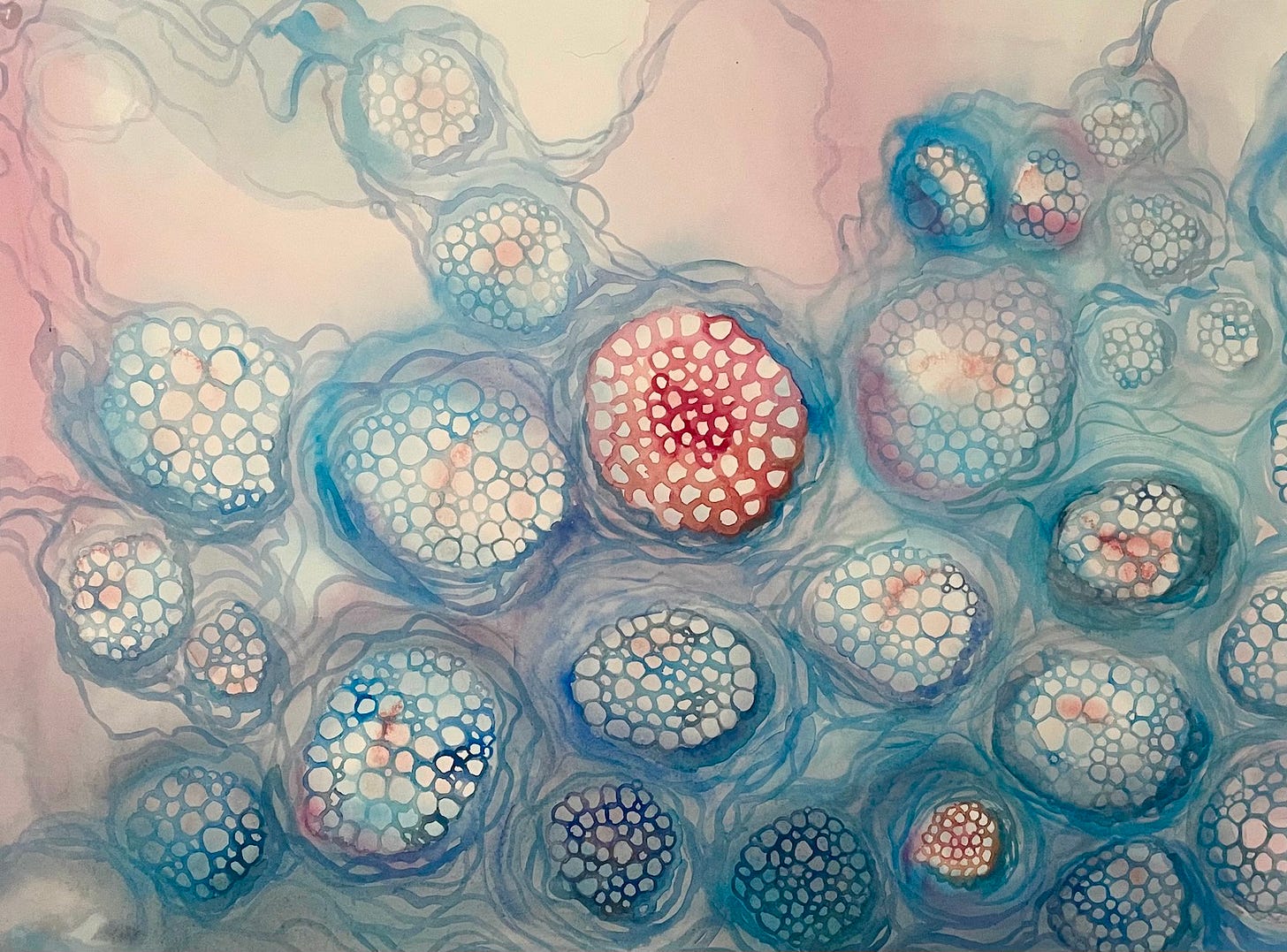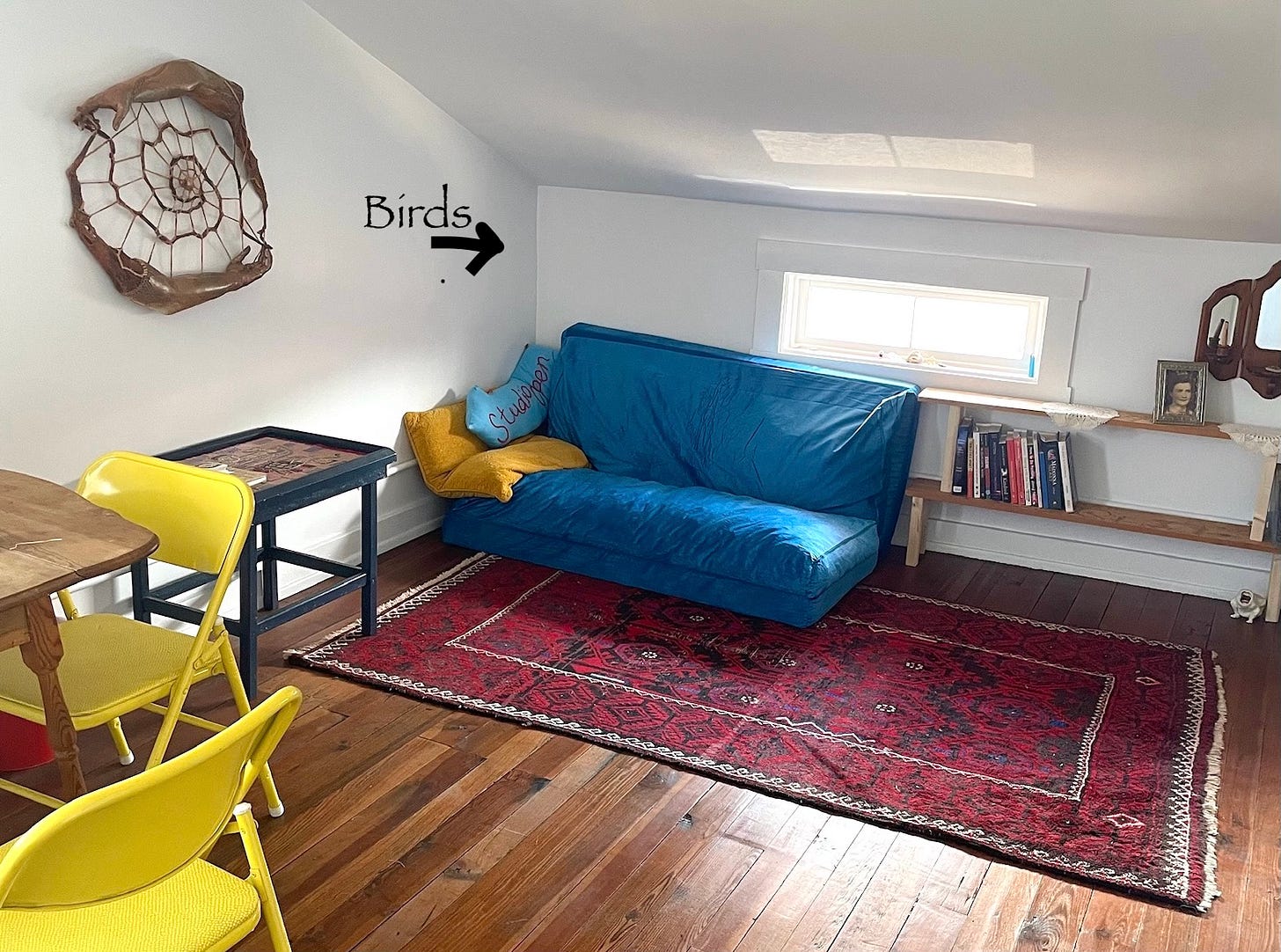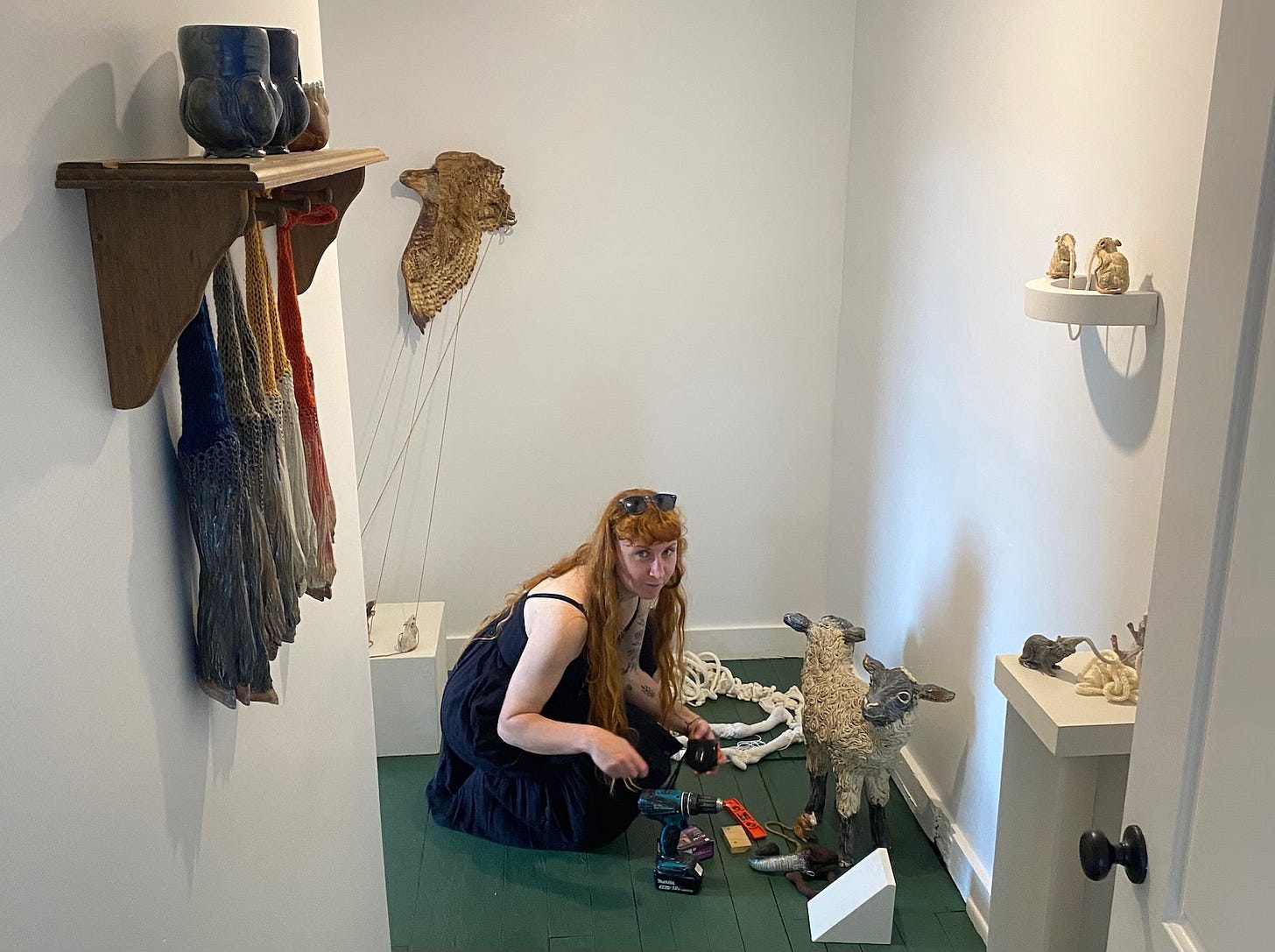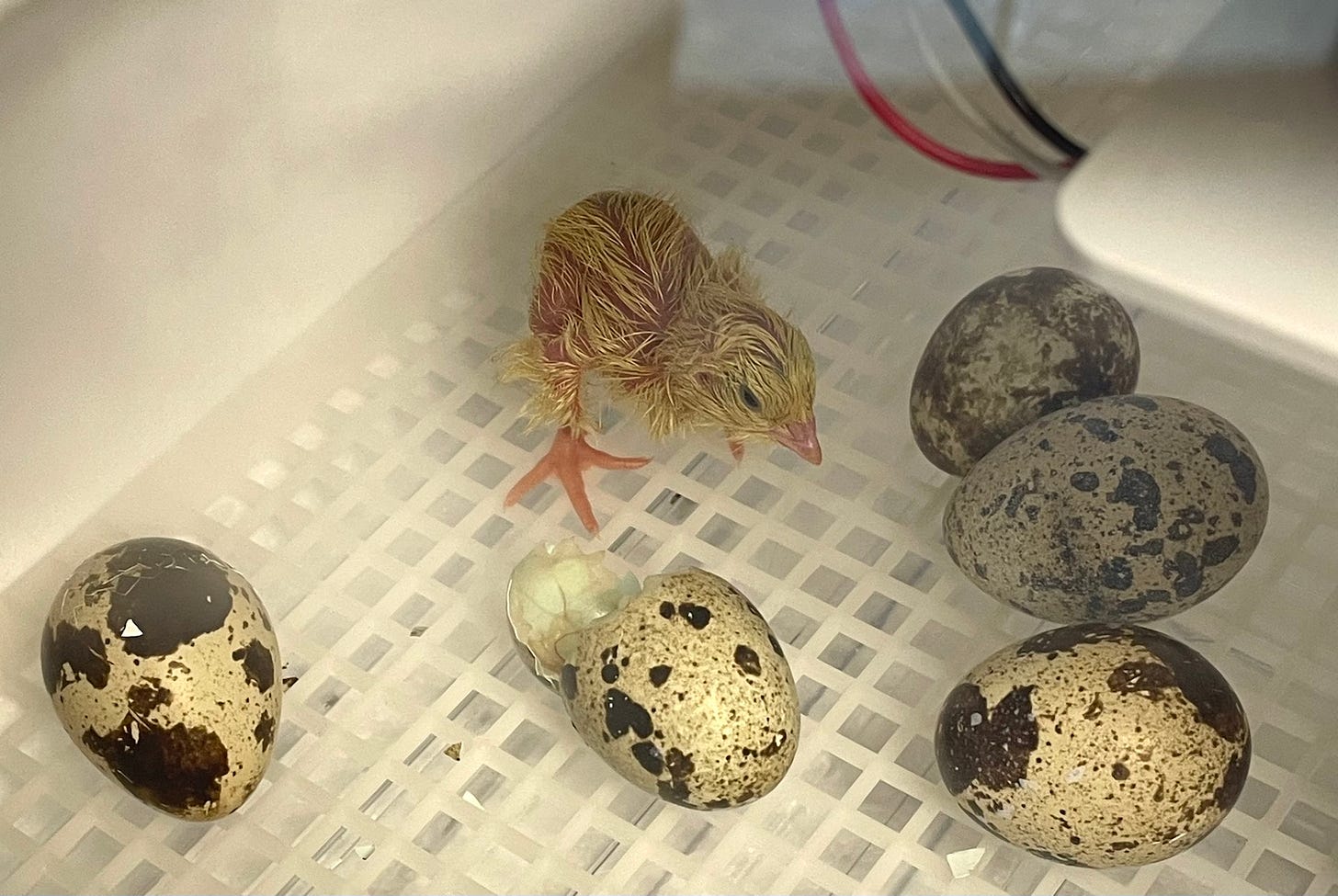I’ve started this newsletter about a dozen times in my head over the past two weeks. repeatedly I ended up just jotting down a few notes and putting it off for tomorrow. And tomorrow. And tomorrow. Now it’s tomorrow I guess, or at least I don’t feel like I can put it off anymore. There is kind of too much to talk about, but I’ll start with the birds.
I’m sitting, writing for the first time in my new studio space—which still feels like the most incredible luxury. I’m in a little attic room in a three-story building, overlooking a mixed industrial area of Cincinnati’s Camp Washington neighborhood. I’m set up in a corner of my studio that is the upper south-west corner of the building. Right on the other side of the brick and plaster wall from my head, tucked into an exterior crack, is a Starling nest. I can hear the tiny chirps of babies as their parents fly in with food and little scrapes of feet and excited movements. There is an almost rhythmic trilling audible through the brick. It is an added sweetness to this space that I’m already absolutely in love with.
I’ve spent more time than usual with birds this month. The arrival of late spring means the early morning hours have become a cacophony of birdsong. Impossible to sleep through, Cardinals, Robins and Wrens dominate, joined by migrating visitors of all colors and sizes. I ended up giving up on sleep a few mornings in a row to sit up before dawn with them. During the first few years of living in my house I was embarrassingly ignorant about the vast complexities of these songs. I say embarrassing, because I have studied birds. I helped find nests and band baby Plover and Tern chicks as a teenager, I did field work observing endangered Rails and went on to college still focused on ornithology. But my midwestern backyard many years later was merely full of a ubiquitous “bird” noise with a few soloists noticeable now and then.
Until something shifted a couple of years ago. I noticed that the song I’d thought was a Cardinal was actually coming from the mouth of a tiny, and very pissed off Carolina Wren in the yew tree next to the deck, telling me I was too close to her nest. This sudden correction to my glassy dismissal of detail in the sounds around the yard brought up a sudden epiphany for me. It feels silly, because I certainly knew this in theory: every bird has its own song. These songs were becoming more interesting, more practically discernable to me personally, like being suddenly able to pick out individual voices in a choir.
Sometime after the Wren encounter I downloaded the Meriln app and completely transformed my relationship to birdsong. Turning theory into practice has been life altering. After a couple of years of paying attention, I was absolutely overjoyed to hear the first Common Nighthawk return a few weeks ago. Then last week the first Eastern Wood Pewee called out its amusingly sweet Peee-oooo-weeeee into the morning and I burst outside with the enthusiasm of a kid running out to meet a visiting loved one who’d been gone too long. These are my neighbors, and I’m learning to know and love them, to depend on them to shake me out of the darkness of these times.
Which brings me back to the little Starlings behind the wall. Murmurations of Starlings are some of the most amazing ecological phenomena and a growing symbol among movement work. Each Starling adapts to the seven birds around it, forming amazing synchronous movements often of thousands of individuals. The visual of murmuration came up over and over this month. From installing a film adaptation of Dani McClain’s short story Homing Instinct at the Weston, and a visit from adrienne maree brown which coincided with that opening, to Cincinnati’s Anti-Despair Earth Fair and days at the community garden, the topic just keeps coming up. The Starlings are everywhere, trying to teach me how to murmurate.
I am decidedly not a good murmurator, or at least I’m still fledgling and clumsy at it. I’m a private person, and I’ve made some choices about my public presence around that identity. As others have stood up on social media against every injustice, I’ve often avoided re-posting news or calls to action. I’ve justified this choice in a few ways. Generally, I look at my engagement with platforms like Instagram with trepidation at best. Empire is clearly in control of these spaces and has been for some time. It is increasingly difficult to know what is real, so I often chose to stay out of public discussion in favor of not accidentally decimating false information. I decided years ago to forgo most types of personal posts in favor of promotion of my artmaking. I further justified my relative quiet online concerning issues I feel strongly about in my actual life because I don’t have what I would consider to be that far of a reach. But, like my birdsong epiphanies, my feelings about this have been steadily shifting. I recently listened to an interview with Steph Speirs of the Sierra Club Foundation that again, in an almost comical way, made me reconsider the obvious. While it is an impossible undertaking for one person to change the world, one person—like a Starling—can help change the behavior and direction of the people around them. Our sphere of influence may be small, but each person standing near us may send ripple effects out into their own unique spheres, beyond our wildest imaginings.
“A voice can change a room, and that is the unit of change that matters.” -Steph Speirs
I am not new to this theory. Even before listening to Speirs’ eloquent re-frame, I was often talking about these ideas with close friends. Yet somehow I had never really thought through the full scope of what shifting individual behavior to inspire collective change could mean in practice. It has always felt scary for me to say things out loud, to show up authentically in unfamiliar spaces. I’ve never aspired to be an influencer. I fancied myself as more of a Great Blue Heron type: stoic, aloof, doing my own thing, not bothering anyone. But as circumstances get undeniably rougher for the vast majority of all beings trying to survive on this planet, it seems well past time to learn how to move together.
I’m still figuring out what that looks like for me, but some of it is tied up in my choice to start this newsletter project. Writing what I’m thinking about out in public still feels very tender and uncomfortable, but it has been incredibly rewarding. My relationship to other platforms is also changing, becoming less gated and more community-centered. My practice of murmuration is also more offline than ever. I’m in the garden, I’m having dinner with beloved friends and family, I’m (gasp) meeting new people and finding delight in expanding my social circles. I’m trying to carve out more time for my human and non-human neighbors in a world of insidious domination and social media anesthesia. If behavior is contagious, I am resolved to think more intentionally about what I want to spread.
5/20/25
Word of the Month
Apotropaic : a-pe-trō-‘pā-ik : adjective
definition: designed to avert evil
Apotropaic motifs can be found throughout history, from carvings of Greek Gorgons to charms worn to repel the evil eye. The word apotropaic comes from the Greek verb apotrépein, meaning “to turn away from, avert,” combining apo- (“away”) with trépein (“to turn”). The magic of apo- doesn’t end there: its influence is evident in many English words, including apology, apostrophe, apostle, and apocalypse.1
Media
The Nature Of Podcast - Every interview is wonderful, I hope you listen if you haven’t already.
Octavia’s Brood - I’ve read so many adjacent books but somehow not this one until now. Entertaining and thought-provoking, the short-story format makes this a quick but profound read.
News!
-I have a new studio space for quilting and dry media! It’s beautiful and I love it. Here’s a picture of me setting up work for the opening last weekend:
-If you are in or near Cincinnati, please go see the show at the Weston Art Gallery which includes the work of James Pate, Bing Davis, and Dani McClain/Lydia Pilcher’s film collaboration linked above. I really loved helping with this installation.
-We have quail! More birds! Babies hatched in late April and should be laying tiny eggs soon!
Thank you for reading!!








